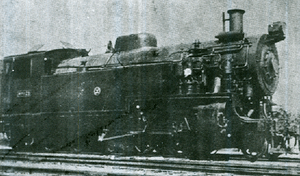Sentetsu Satai-class locomotive
| Chosen Government Railway Satai class (サタイ) Korean National RR Sata class (사타) Korean State Railway Sadaha class (사다하) | |||||||||||||||||||||||||||||||||||||||||||||||||||
|---|---|---|---|---|---|---|---|---|---|---|---|---|---|---|---|---|---|---|---|---|---|---|---|---|---|---|---|---|---|---|---|---|---|---|---|---|---|---|---|---|---|---|---|---|---|---|---|---|---|---|---|
 Sentetsu's サタイ21 after completion at the Busan Shops in 1939. | |||||||||||||||||||||||||||||||||||||||||||||||||||
| |||||||||||||||||||||||||||||||||||||||||||||||||||
| |||||||||||||||||||||||||||||||||||||||||||||||||||
| |||||||||||||||||||||||||||||||||||||||||||||||||||
| |||||||||||||||||||||||||||||||||||||||||||||||||||
The Satai class (サタイ) class locomotives were a class of large steam tank locomotives of the Chosen Government Railway (Sentetsu) with 2-10-2T wheel arrangement.[1] The "Sata" name came from the American naming system for steam locomotives, under which locomotives with 2-10-2 wheel arrangement were called "Santa Fe".[2]
Description
The Satai class were large tank locomotives with high tractive effort, designed specifically for use on mountainous lines. Designed locally, a total of 24 were delivered to Sentetsu, the first four being built in 1934 at the Gyeongseong Works, and the last five in 1939 by Hitachi.[1] Originally numbered 1801 through 1819, they received the サタイ1 through サタイ19 numbers in Sentetsu's general renumbering of 1938, while サタイ20–サタイ24 were built in 1939, after the new numbering system was introduced.[3]
Postwar
In the division of railway assets between North and South, sixteen of the Satai class locomotives went to the Korean State Railway in the North, designated 사다하 (Sadaha) class, and eight to the Korean National Railroad in the South, as 사타 (Sata) class.[3]
Construction
| Original number | 1938 number | Build year | Builder | Assembly location | Postwar owner | Postwar number | Notes |
|---|---|---|---|---|---|---|---|
| 1801 | サタイ1 | 1934 | Gyeongseong | Gyeongseong | ? | ||
| 1802 | サタイ2 | 1934 | Gyeongseong | Gyeongseong | KNR | 사타2 | Retired by 1953 and stored at Susaek Station near Seoul.[3] |
| 1803 | サタイ3 | 1934 | Gyeongseong | Gyeongseong | KNR | 사타3 | Retired by 1953 and stored at Susaek Station near Seoul.[3] |
| 1804 | サタイ4 | 1934 | Gyeongseong | Gyeongseong | ? | ||
| 1805 | サタイ5 | 1935 | Hitachi (日本車輌) | Gyeongseong | ? | ||
| 1806 | サタイ6 | 1935 | Hitachi (日本車輌) | Gyeongseong | ? | ||
| 1807 | サタイ7 | 1935 | Hitachi (日本車輌) | Gyeongseong | ? | ||
| 1808 | サタイ8 | 1935 | Hitachi (日本車輌) | Gyeongseong | ? | ||
| 1809 | サタイ9 | 1936 | Gyeongseong | Gyeongseong | ? | ||
| 1810 | サタイ10 | 1936 | Gyeongseong | Gyeongseong | ? | ||
| 1811 | サタイ11 | 1937 | Hitachi (日本車輌) | Sentetsu Busan shops | ? | ||
| 1812 | サタイ12 | 1937 | Hitachi (日本車輌) | Sentetsu Busan shops | ? | ||
| 1813 | サタイ13 | 1937 | Hitachi (日本車輌) | Sentetsu Busan shops | ? | ||
| 1814 | サタイ14 | 1937 | Hitachi (日本車輌) | Sentetsu Busan shops | ? | ||
| 1815 | サタイ15 | 1937 | Hitachi (日本車輌) | Sentetsu Busan shops | ? | ||
| 1816 | サタイ16 | 1937 | Hitachi (日本車輌) | Sentetsu Busan shops | ? | ||
| 1817 | サタイ17 | 1937 | Hitachi (日本車輌) | Sentetsu Busan shops | ? | ||
| 1818 | サタイ18 | 1937 | Hitachi (日本車輌) | Sentetsu Busan shops | ? | ||
| 1819 | サタイ19 | 1937 | Hitachi (日本車輌) | Sentetsu Busan shops | ? | ||
| サタイ20 | 1939 | Hitachi (日本車輌) | Sentetsu Busan shops | ? | |||
| サタイ21 | 1939 | Hitachi (日本車輌) | Sentetsu Busan shops | KNR | 사타21 | Retired by 1953 and stored at Susaek Station near Seoul.[3] | |
| サタイ22 | 1939 | Hitachi (日本車輌) | Sentetsu Busan shops | ? | |||
| サタイ23 | 1939 | Hitachi (日本車輌) | Sentetsu Busan shops | KNR | 사타23 | Retired by 1953 and stored at Susaek Station near Seoul.[3] | |
| サタイ24 | 1939 | Hitachi (日本車輌) | Sentetsu Busan shops | ? | |||
| Total | 24 |
References
- 1 2 Byeon, Seong-u (1999). 한국철도차량 100년사 [Korean Railways Rolling Stock Centennial] (in Korean). Seoul: Korea Rolling Stock Technical Corp. p. 42–43.
- ↑ Colvin, Fred H. (1906). The railroad pocket-book: a quick reference cyclopedia of railroad information. New York, Derry-Collard; London, Locomotive Publishing Company (US-UK co-edition). p. L‑9.
- 1 2 3 4 5 6 "Korean National RR Class SF 2-10-2T". donsdepot.donrossgroup.net.